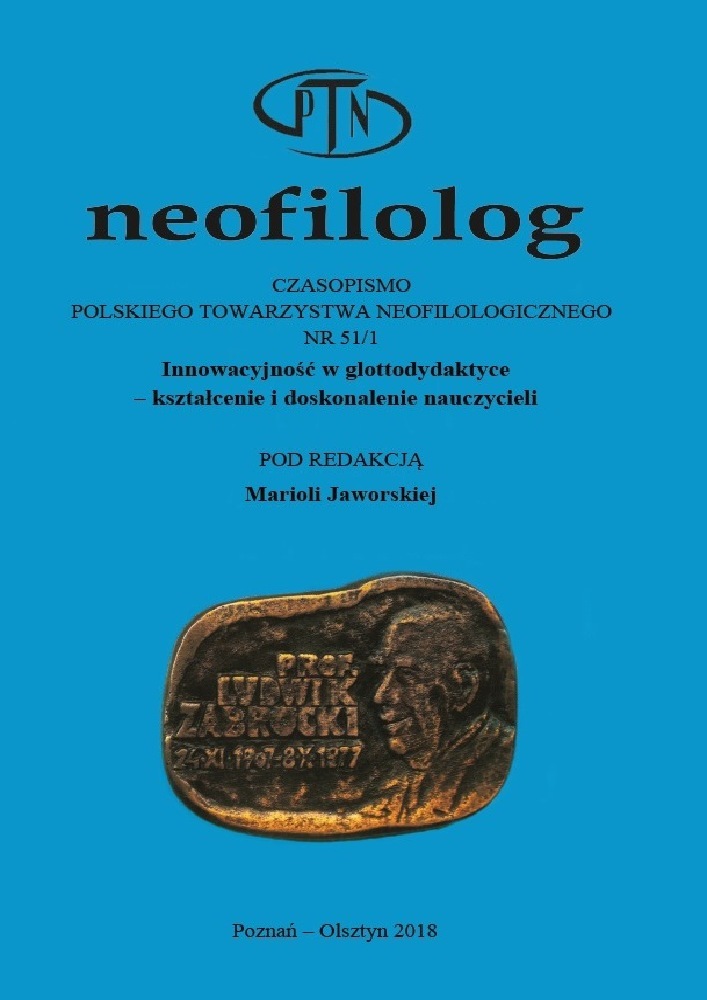Résumé
The world is changing. Is the teaching of foreign languages also bound to change? The answer to the question is not about confirming that almost all learners have their smartphones now. After all, language teaching is not aimed at following all new fashion trends. The decisive factor is the fact that today's learners are different from those 10 or 15 years back. They are characterised by growing linguistic (and usually also cultural) diversity, their network of contacts with the world, family relationships and personal experiences are more diversified and colourful. Also, requirements towards them change: they need to be able to adapt to the rapidly developing world, the world of globalisation and of nationalistic tendencies. How can foreign language education contribute to their finding their place in a society of open borders, linguistic and cultural diversity, and new possibilities offered to each of them? In response to the question, the author encourages everyone to ponder on the following topics:
- How do learners contribute to the learning process and foreign language instruction: diversity as capital
- Plurilingualism is the main principle of language education and school development
- Action-based vs. task-based: how autonomous can learners be?
- Learning on the Web: foreign languages are learnt not only during lessons
- Professional development and reflection as the essence of teaching competence in a contemporary school
Références
Dietrich, Ingrid (Hg.): Handbuch Freinet-Pädagogik. Beltz: Weinheim 1995.
Duxa, Susanne: Fortbildungsveranstaltungen für DaZ-Kursleiter in der Weiterbildung und ihre Wirkung auf das professionelle Selbst der Lehrenden. (Materialien Deutsch als Fremdsprache – FaDaF,Bd. 57), Regensburg 2001.
Europäisches Portfolio für Sprachlehrende in Ausbildung (EPOSA). Europäisches Fremdsprachenzentrum: http://archive.ecml.at/mtp2/publications/C3_ Epostl_D_internet.pdf.
Europäisches Profilraster für Sprachlehrende (EPR): https://www.goethe.de/ resources/files/pdf22/EPR_Verffentlichung_Deutsch.pdf.
Göbel, Richard: Verschiedenheit und gemeinsames Lernen. Scriptor: Kron-berg. 2. Auflage 1986 unter dem Titel: Kooperative Binnendifferenzie-rung im Fremdsprachenunterricht. Werkmeister: Mainz 1981/1986.
Gogolin, Ingrid/ Lange, Imke/ Michel, Ute/ Reich, Hans H. (Hg.): Herausforderung Bildungssprache – und wie man sie meistert. (FörMig-Edition, Bd. 9). Waxmann: Münster 2013.
Hattie, John: Teachers Make a Di erence, What is the research evidence?: http://research.acer.edu.au/cgi/viewcontent.cgi?article=1003&context=resear ch_conference_2003.
Hattie, John: Visible Learning. Routledge: London 2009.
Hufeisen, Britta/Lutjeharms, Madeline: Gesamtsprachencurriculum, Integrierte Sprachendidaktik, Common Curriculum. Narr: Tübingen 2005.
Krumm, Hans-Jürgen: Kinder und ihre Sprachen – lebendige Mehrsprachig-keit. Hrsg. von H.-J. Krumm/E.-M. Jenkins. Eviva: Wien 2001.
Krumm, Hans-Jürgen/ Reich, Hans H.: Curriculum Mehrsprachigkeit (2011): http://oesz.at/download/cm/CurriculumMehrsprachigkeit2011.pdf
Lernen durch Lehren: http://www.ldl.de.Portmann-Tselikas, Paul R.: Aufgaben statt Fragen. Sprachenlernen im Unterricht und die Ausbildung von Fertigkeiten. In: Fremdsprache Deutsch 24 (2001): 13-18.
Reich, Hans H./Krumm, Hans-Jürgen: Sprachbildung und Mehrsprachigkeit. Ein Curriculum zur Wahrnehmung und Bewältigung sprachlicher Viel-falt im Unterricht. Waxmann: Münster 2013.
Schart, Michael/ Legutke, Michael: Lehrkompetenz und Unterrichtsgestal-tung (=Goethe-Institut: Deutsch Lehren Lernen – DLL 1). Langen-scheidt: München 2012.
Schule mehrsprachig: http://www.schule-mehrsprachig.at/Wegner, Anke/ Dirim, Inci (Hg.): Mehrsprachigkeit und Bildungsgerechtigkeit. Budrich: Opladen/ Toronto 2016.
Wegner, Anke/ Vetter, Eva (Hg.): Mehrsprachigkeit und Professionalisierung in pädagogischen Berufen. Budrich: Opladen/Toronto 2014.
Licence
© Neofilolog 2019

Ce travail est disponible sous licence Creative Commons Attribution - Pas de Modification 4.0 International.
Auteurs :
Les auteurs de textes acceptés pour publication dans la revue Neofilolog sont tenus de remplir, signer et renvoyer à l'adresse de la rédaction, un accord sur l'octroi d'une licence gratuite pour les œuvres, avec obligation d'accorder une sous-licence CC.
En vertu de cet accord, les auteurs des textes publiés dans la revue Neofilolog accordent à l'Université Adam Mickiewicz de Poznań une licence non exclusive et gratuite et permettent l'utilisation de la sous-licence Creative Commons Attribution-NoDerivatives 4.0 International (CC BY-ND 4.0).
Les auteurs se réservent le droit de disposer librement de l'œuvre.
Utilisateurs :
Les utilisateurs d'Internet intéressés ont le droit d'utiliser les œuvres publiées à partir de l'année 2017 sous réserve des conditions suivantes :
- reconnaissance de la qualité d'auteur - l'obligation de fournir des informations sur la qualité d'auteur, le titre, la source (liens vers l'œuvre originale, DOI) et la licence, ainsi que l'œuvre distribuée ;
- sans créer d'œuvres dérivées - l'œuvre doit être conservée dans sa forme originale, p. ex. les traductions ou les interprétations ne peuvent être distribuées sans le consentement de l'auteur.
Tous les textes publiés sont soumis au droit d'auteur.
Autres :
L'Université Adam Mickiewicz de Poznań se réserve le droit à la revue dans son ensemble (mise en page, forme graphique, titre, conception de la couverture, logo, etc.).
.
